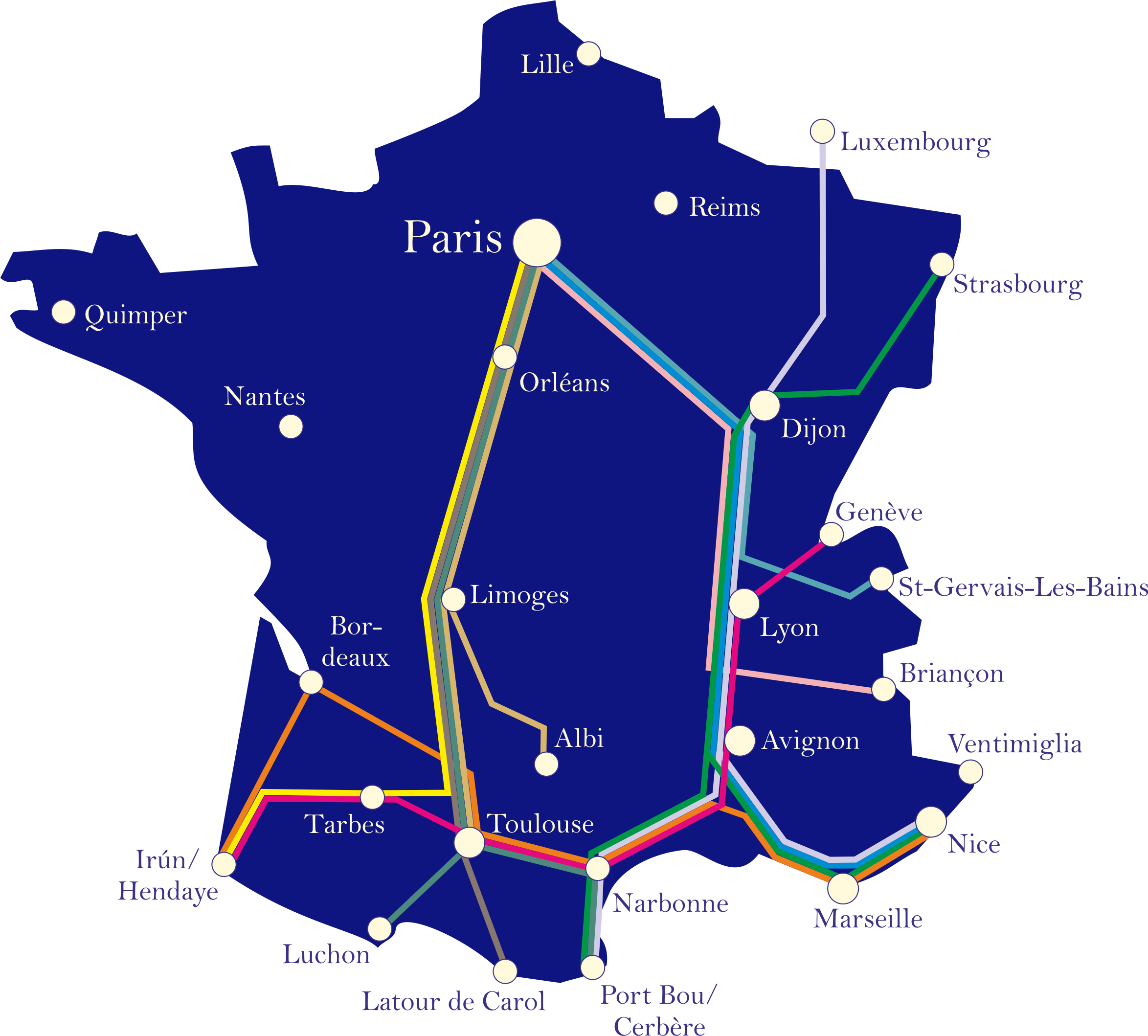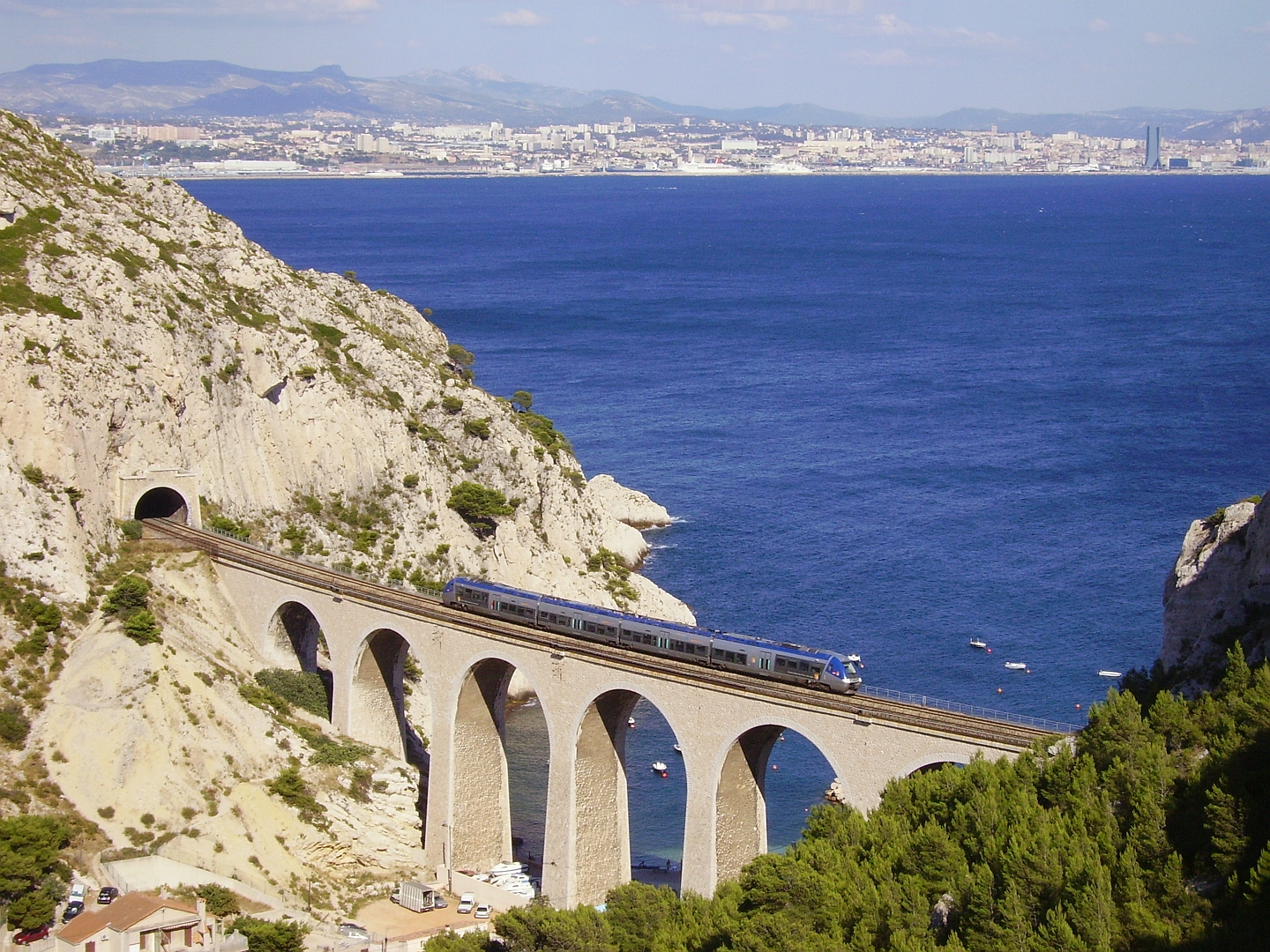|
Figeac Station
Figeac is a railway station in Figeac, Occitanie, France. The station is a ''keilbahnhof'', situated at the junction of the Brive–Toulouse (via Capdenac) railway and Figeac–Arvant railway lines. The station is served by Intercités de nuit (night train) and TER (local) services operated by SNCF. The station was mostly destroyed by a fire of mysterious origin overnight the 21-22 of November 2018. Despite the efforts of around fifty firefighters from Figeac and surrounding areas, the station's smoke-stained walls were pretty much all that remained standing. An inquiry ruled the fire as "accidental," but questions remain. Reconstruction of the station began in 2021, and it is expected to re-open to passengers in early 2023. In the meantime, SNCF has moved its operations to a nearby parking lot where buses and trains now embark their passengers. The station itself is located south of the river Célé, near the ''Hotel de Ville''. It is easily accessed from the N122 and s ... [...More Info...] [...Related Items...] OR: [Wikipedia] [Google] [Baidu] |
Figeac
Figeac (; oc, Fijac) is a commune in the Lot department in south-western France. Figeac is a sub-prefecture of the department. Geography Figeac is on the via Podiensis, a major hiking medieval pilgrimage trail which is part of the Way of St. James. Today, as a part of France's system of trails it is labelled the GR 65. Figeac station is a railway junction with connections to Brive-la-Gaillarde, Toulouse, Aurillac and Rodez. Population Notable people Jean-François Champollion, the first translator of Egyptian hieroglyphics, was born in Figeac, where there is a Champollion Museum. His father had married a woman from Figeac and opened a bookshop in the village. On the ''"Place des écritures"'' (writings place) is a giant copy of the Rosetta stone, by Joseph Kosuth. French explorer and archeologist Théodore Ber was born in Figeac, although he spent most of his adult life in Peru. German film historian Lotte H Eisner hid from the Nazis in Figeac during World War II. A ... [...More Info...] [...Related Items...] OR: [Wikipedia] [Google] [Baidu] |
Occitania (administrative Region)
Occitania ( ; french: Occitanie ; oc, Occitània ; ca, Occitània ) is the southernmost administrative region of metropolitan France excluding Corsica, created on 1 January 2016 from the former regions of Languedoc-Roussillon and Midi-Pyrénées. The Council of State approved Occitania as the new name of the region on 28 September 2016, coming into effect on 30 September 2016. The modern administrative region is named after the larger cultural and historical region of Occitania, which corresponds with the southern third of France. The region of Occitania as it is today covers a territory similar to that ruled by the Counts of Toulouse in the 12th and 13th centuries. The banner of arms of the Counts of Toulouse, known colloquially as the Occitan cross, is used by the modern region and is also a popular cultural symbol. In 2015, Occitania had a population of 5,839,867. Toponymy Enacted in 2014, the territorial reform of French regions had been subject to debate for many ... [...More Info...] [...Related Items...] OR: [Wikipedia] [Google] [Baidu] |
Keilbahnhof
''Keilbahnhof'' (plural: ''Keilbahnhöfe'', literally: "wedge station") is the German word for a station located between branching tracks.Ernst, Dr.-Ing. Richard (1989). ''Wörterbuch der Industriellen Technik'' (5th ed.). Wiesbaden: Oscar Brandstetter, 1989. . There appears to be no direct English equivalent for this term. In a ''keilbahnhof'', the platforms curve in opposite directions so that they are parallel at one end of the station and not at the other. Definition A ''Keilbahnhof'' is a type of junction station whose tracks usually diverged before passing the platforms, the station building being located between the tracks. The through tracks thus pass by on either side without rejoining one another again, in contrast to an island station, in which the tracks merge again after passing either side of the station building. There are also ''Keilbahnhof'' stations whose through tracks diverge in the area of the platforms, but never after them. The y-shaped ''Keilbahnhof'' is ... [...More Info...] [...Related Items...] OR: [Wikipedia] [Google] [Baidu] |
Brive-la-Gaillarde - Toulouse (via Capdenac) Railway
Brive-la-Gaillarde (; Limousin dialect of oc, Briva la Galharda) is a commune of France. It is a sub-prefecture and the largest city of the Corrèze department. It has around 46,000 inhabitants, while the population of the agglomeration was 75,579 in 2019. Although it is by far the biggest commune in Corrèze, the capital is Tulle. In French popular culture, the town is associated with a song by Georges Brassens. History Even though the inhabitants settled around the 1st century, the city only started to grow much later. From around the 5th century onwards, the original city began to develop around a church dedicated to Saint-Martin-l'Espagnol. During the 12th century walls were built around the city and during the Hundred Years' War a second wall was built. These fortifications no longer exist and have been replaced by boulevards. The commune was named "Brive" until 1919, when it was renamed "Brive-la-Gaillarde". The word "Gaillarde" (still used in current French) prob ... [...More Info...] [...Related Items...] OR: [Wikipedia] [Google] [Baidu] |
Intercités De Nuit
Intercités de Nuit is a brand name used by France’s national railway company, SNCF, to denote overnight passenger rail services in France. It was known as ''Corail Lunéa'' before 2009 and as ''Lunéa'' from 2010 to 2012. Between 2013 and 2017, most services were cancelled due to budget cuts. Only four routes, from Paris to Briançon, Albi, Latour de Carol and Nice, were kept.SNCF Intercités, Lignes de nuit retrieved 16 November 2017 The brand has since been reintegrated into the main network. Network in 2022 As of 2022, the Intercités de Nuit network consisted of the following lines:[...More Info...] [...Related Items...] OR: [Wikipedia] [Google] [Baidu] |
Transport Express Régional
Transport express régional (, usually shortened to TER) is the brand name used by the SNCF, the French national railway company, to denote rail service run by the regional councils of France, specifically their organised transport authorities. The network serves French regions; Île-de-France ( Transilien) and Corsica (CFC) have their own specific transport systems. Every day, over 800,000 passengers are carried on 5,700 TER-branded trains.Le TER en 2030 ''SNCF'' Retrieved 2011-02-15 TER is part of SNCF Voyageurs, a branch of the SNCF dealing with urban and regional passenger rail, which also includes Transilien, [...More Info...] [...Related Items...] OR: [Wikipedia] [Google] [Baidu] |
SNCF
The Société nationale des chemins de fer français (; abbreviated as SNCF ; French for "National society of French railroads") is France's national state-owned railway company. Founded in 1938, it operates the Rail transport in France, country's national rail traffic along with Monaco, including the TGV, on France's high-speed rail network. Its functions include operation of railway services for passengers and freight (through its subsidiaries SNCF Voyageurs and Rail Logistics Europe), as well as maintenance and signalling of rail infrastructure (SNCF Réseau). The railway network consists of about of route, of which are high-speed lines and electrified. About 14,000 trains are operated daily. In 2010 the SNCF was ranked 22nd in France and 214th globally on the Fortune Global 500 list. It is the main business of the SNCF Group, which in 2020 had €30 billion of sales in 120 countries. The SNCF Group employs more than 275,000 employees in France and around the world. Since ... [...More Info...] [...Related Items...] OR: [Wikipedia] [Google] [Baidu] |
Gare Figeac Summer 2020
Gare is the word for "station" in French and related languages, commonly meaning railway station Gare can refer to: People * Gare (surname), surname * The Gare Family, fictional characters in the novel '' Wild Geese'' by Martha Ostenso Places * Gare, Zavidovići, Bosnia and Herzegovina * Gare (Gadžin Han), a village situated in Gadžin Han municipality in Serbia * Garé, Hungary * Gare, Luxembourg, neighborhood around the railway station in Luxembourg City, Luxembourg * Gare Loch, an open see loch in Argyll and Bute, Scotland * Pompoï-gare, Pompoï-gare is a village in the Pompoï Department of Balé Province in southern Burkina Faso * South Gare, an area of reclaimed land and breakwater on the southern side of the mouth of the River Tees in Redcar and Cleveland, England ** South Gare & Coatham Sands SSSI, Site of Special Scientific Interest ** South Gare Lighthouse, at the end of the South Gare breakwater Transportation ''Gare'' refers to many stations in Francophone and o ... [...More Info...] [...Related Items...] OR: [Wikipedia] [Google] [Baidu] |
Célé
The Célé is a long river in the Cantal and Lot departments in south-western France, a tributary of the Lot. Its source is near Calvinet in the Cantal. It flows generally west through the following departments and towns: * Cantal: Saint-Constant * Lot: Bagnac-sur-Célé, Figeac Figeac (; oc, Fijac) is a commune in the Lot department in south-western France. Figeac is a sub-prefecture of the department. Geography Figeac is on the via Podiensis, a major hiking medieval pilgrimage trail which is part of the Way of S ... The Célé flows into the Lot at Bouziès. References Rivers of France Rivers of Auvergne-Rhône-Alpes Rivers of Occitania (administrative region) Rivers of Cantal Rivers of Lot (department) {{France-river-stub ... [...More Info...] [...Related Items...] OR: [Wikipedia] [Google] [Baidu] |
Decazeville
Decazeville ( oc, La Sala) is a commune in the Aveyron department in the Occitanie region in southern France. The commune was created in the 19th century because of the Industrial Revolution and was named after the Duke of Decazes (1780–1860), the founder of the factory that created the town. Viviez-Decazeville station has rail connections to Brive-la-Gaillarde, Figeac and Rodez. History The town is built on coal. La Salle (the former name) produced coal since the 16th century. It was exported in small quantities to Bordeaux. Louis XIV and his successors gave mines to their mistresses. The Duke of Decazes inherited such mines. In 1826 he created, with the help of a technician named Cabrol, the ''"Houillères et Fonderies de l'Aveyron"'' (Mines and Foundries of Aveyron) which developed to make this small village a center of ironworking and industry. Under Napoléon III, the city took the name of Decazeville. A statue of Decazes dressed in a Roman toga was erected. The h ... [...More Info...] [...Related Items...] OR: [Wikipedia] [Google] [Baidu] |
Railway Stations In Lot (department)
Rail transport (also known as train transport) is a means of transport that transfers passengers and goods on wheeled vehicles running on rails, which are incorporated in tracks. In contrast to road transport, where the vehicles run on a prepared flat surface, rail vehicles (rolling stock) are directionally guided by the tracks on which they run. Tracks usually consist of steel rails, installed on sleepers (ties) set in ballast, on which the rolling stock, usually fitted with metal wheels, moves. Other variations are also possible, such as "slab track", in which the rails are fastened to a concrete foundation resting on a prepared subsurface. Rolling stock in a rail transport system generally encounters lower frictional resistance than rubber-tyred road vehicles, so passenger and freight cars (carriages and wagons) can be coupled into longer trains. The operation is carried out by a railway company, providing transport between train stations or freight customer facilit ... [...More Info...] [...Related Items...] OR: [Wikipedia] [Google] [Baidu] |




